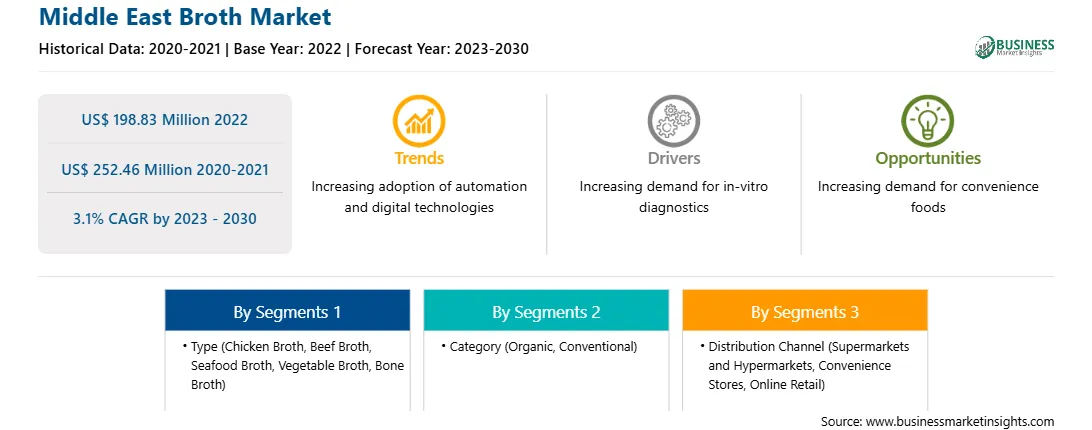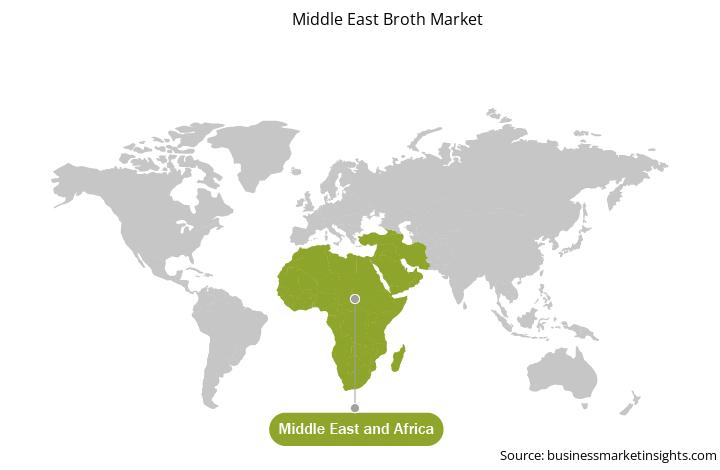Broth is a savory liquid or powder is made by boiling meat, fish, vegetables, bones, and other ingredients including seasonings and flavors in water. The liquid broth is concentrated and canned or packed in cartons. The powdered broth is made by spray drying the liquid broth and packaged in pouches or formed into cubes. Broth is a rich source of protein and is usually consumed before or during meal. It has a unique flavor and aroma owing to which it is gaining popularity among consumers who are concerned about their health but don’t want to compromise on taste and flavor.
The style of broth packaging is undergoing notable changes with a shift in consumer preferences. Broth cartons in single-serve and larger reclosable sizes have replaced broth cans that were common in aisles at malls, supermarkets, etc. Bone broths are offered in boxes, cartons, spouted gusset pouches, glass containers, and K-cups. The pouches have pouring spouts that ease opening and pouring activities. Manufacturers are focusing on developing innovative packaging solutions to avoid leakages. Further, some brands have developed packaging methods that can help prolong broth shelf life by 0.5–2 years. Cartons are convenient to use and easy to recycle. They require lower space during transport and reduce the overall weight of a shipment. This type of packaging is creative and attractive and grabs the attention of consumers, especially the younger generations. Thus, innovations in packaging solutions are expected to create lucrative growth opportunities for companies operating in the Middle East broth market in the coming years.
Further, broth manufacturers are using recyclable and biodegradable packaging materials due to rising sustainability concerns among consumers. In September 2020, Nestle SA launched Maggi organic bouillon cubes in a recyclable paper wrapper. Such packaging initiatives by market players are expected to open new opportunities for the broth market in the Middle East during the forecast period.
The organized retail sector has undergone a massive transformation in recent years. The popularity of e-commerce has increased considerably due to a rise in the penetration of the internet and smartphones, easy access to emerging technologies, upsurge in the purchasing power of people, and its ability to transform the shopping experience of customers by proving convenient shopping from anywhere and anytime using online retail platforms. People prefer online retail platforms to buy these products owing to availability of detailed product descriptions, various products of many brands at affordable prices, home delivery services, and consumer ratings and reviews. Moreover, broth manufacturers prefer e-commerce platforms over physical stores to expand sales and gain a large customer reach with minimal investments. Thus, the growth of e-commerce platforms across the region fuels the Middle East broth market.
Based on category, the Middle East broth market is segmented into organic and conventional. In 2023, the conventional segment held the largest market share. Conventional products are grown using powerful chemicals to help manage fertility, prevent contamination by pests, and reduce the risks of diseases. Animals raised on conventional and grass-fed farms can be exposed to toxins from fertilizers, pesticides, and insecticides sprayed on pastures. Furthermore, consumption of water and other products from nonorganic or conventional farms can result in lead toxicity, which causes headaches, impaired growth, behavioral problems, lack of energy, and learning difficulties. The broth is free of toxins and helps treat specific health ailments such as autoimmunity and allergies. Further, the processing of conventional broth is simpler than organic broth. It is easily available and more affordable. These factors are boosting the demand for conventional broth, which is driving the segment growth.
A few primary and secondary sources referred to while preparing this report on the Middle East broth market are paid databases (Factiva), publications, hoovers, investor presentations, newsletters, sec archives, annual reports, and other information available in the public domain. Major companies operating in the Middle East broth market listed in the report are Paarman Foods (Pty) Ltd, Podravka Inc, Basamh Marketing Co, Sottolestelle SRL, The Manischewitz Co, Campbell Soup Co, Kettle & Fire Inc, Brite Start LLC, Nestle SA, and Unilever Plc.
Strategic insights for the Middle East Broth provides data-driven analysis of the industry landscape, including current trends, key players, and regional nuances. These insights offer actionable recommendations, enabling readers to differentiate themselves from competitors by identifying untapped segments or developing unique value propositions. Leveraging data analytics, these insights help industry players anticipate the market shifts, whether investors, manufacturers, or other stakeholders. A future-oriented perspective is essential, helping stakeholders anticipate market shifts and position themselves for long-term success in this dynamic region. Ultimately, effective strategic insights empower readers to make informed decisions that drive profitability and achieve their business objectives within the market.

| Report Attribute | Details |
|---|---|
| Market size in 2022 | US$ 198.83 Million |
| Market Size by 2030 | US$ 252.46 Million |
| Global CAGR (2023 - 2030) | 3.1% |
| Historical Data | 2020-2021 |
| Forecast period | 2023-2030 |
| Segments Covered |
By Type
|
| Regions and Countries Covered | Middle East and Africa
|
| Market leaders and key company profiles |
The geographic scope of the Middle East Broth refers to the specific areas in which a business operates and competes. Understanding local distinctions, such as diverse consumer preferences (e.g., demand for specific plug types or battery backup durations), varying economic conditions, and regulatory environments, is crucial for tailoring strategies to specific markets. Businesses can expand their reach by identifying underserved areas or adapting their offerings to meet local demands. A clear market focus allows for more effective resource allocation, targeted marketing campaigns, and better positioning against local competitors, ultimately driving growth in those targeted areas.

The Middle East Broth Market is valued at US$ 198.83 Million in 2022, it is projected to reach US$ 252.46 Million by 2030.
As per our report Middle East Broth Market, the market size is valued at US$ 198.83 Million in 2022, projecting it to reach US$ 252.46 Million by 2030. This translates to a CAGR of approximately 3.1% during the forecast period.
The Middle East Broth Market report typically cover these key segments-
The historic period, base year, and forecast period can vary slightly depending on the specific market research report. However, for the Middle East Broth Market report:
The Middle East Broth Market is populated by several key players, each contributing to its growth and innovation. Some of the major players include:
The Middle East Broth Market report is valuable for diverse stakeholders, including:
Essentially, anyone involved in or considering involvement in the Middle East Broth Market value chain can benefit from the information contained in a comprehensive market report.